How to Paint Uploaded Photo in Sketch Up
Have you ever stuck a decal on a window or a wall? In SketchUp, sticking an image on a face is fifty-fifty easier than those decals, considering digital images don't contraction or trap air bubbles.
Technically speaking, SketchUp enables you to import images that are already on your hard drive. When yous import images from your hard drive (select File > Import to see the Open dialog box, shown in the figure), you tin can import the image as an image, a texture, or a matched photograph.

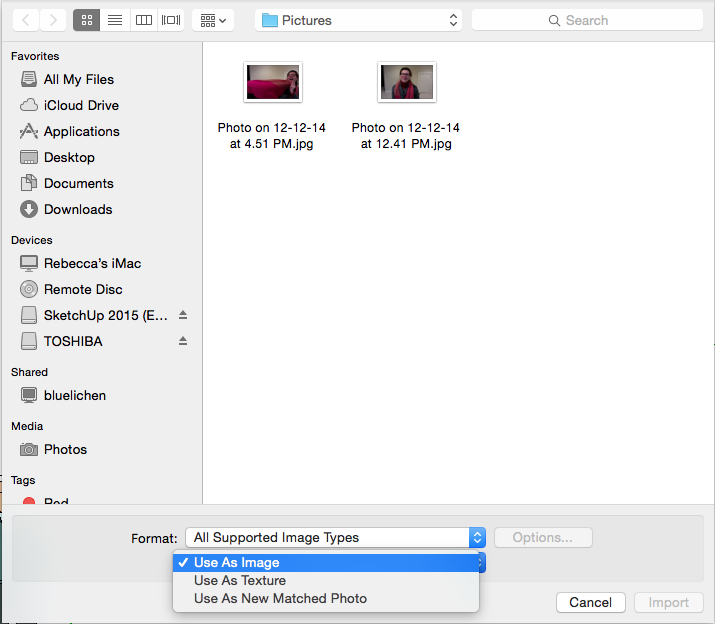
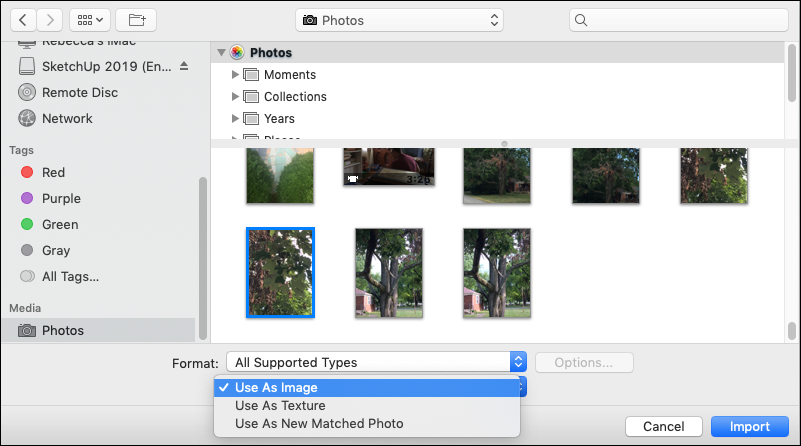
Here's how those options help you lot do different things with the image in your model:
- Import the image as a basic epitome, and SketchUp enables you to place the image anywhere in your model. You lot can then move, rotate, scale, or stretch the image.
- Import the paradigm as a texture, and y'all tin use the epitome to an existing confront. However, you lot as well gain access to all the materials and Position Texture tools. These tools are introduced in Adding Colors and Textures with Materials, but that article focuses on tiled images. In this commodity, find out how to do special techniques with a single image, such every bit wrapping an image around corners, wrapping an prototype around a hidden confront on a cylinder, or projecting an image onto a face. When you lot project textures, you tin use them to curved surfaces.
- Import the image as a matched photograph, and you activate SketchUp'southward Friction match Photo tool, which enables you to match a photograph of an existing building to a model of that edifice or draw a edifice based on a photograph. Friction match Photo enables you to employ images to buildings two faces at time, using the corner of a building or room to apply a 2D image onto a 3D model. Unlike images or textures, which work best with rectangular images and faces, Match Photo works well with non-rectangular edifice shapes, such as angled roof lines. Learn all about Match Photo in Matching a Photo to a Model (or a Model to a Photograph).
Tip: If your model is spherical, these tools likely won't piece of work well for you. The one exception is projected textures, which you can apply to curved (or seemingly curved) surfaces. (For details most how SketchUp makes flat faces look smooth, come across Softening, Smoothing, and Hiding Geometry.
Table of Contents
- Understanding prototype basics
- Importing a 2nd image
- Applying a texture to the side of a building
- Wrapping textures around boxes and cylinders
- Projecting textures
Agreement prototype nuts
Digital images come in myriad file types and sizes. SketchUp supports the image file formats outlined in the post-obit table. Some formats may exist more than advisable than others for sure types of images and applications.
| Microsoft Windows and macOS | Microsoft Windows | macOS |
|---|---|---|
| JPEG, PNG, EPS, TIFF | TGA, BMP | PDF, PICT, PSD, SGI |
An image's size is referred to equally its resolution. An epitome'southward resolution reflects how many pixels the epitome contains. The resolution of an image depends on the epitome source. Typically, images captured with a digital camera, especially a dSLR photographic camera, have very high resolutions, and images downloaded from the web have depression resolutions. Y'all can cheque an image's resolution in an epitome editing program, such every bit Photoshop.
Tip: The higher an image's resolution, the more than particular you lot see in the image. However, a high resolution also makes the image file bigger, which in turn makes your SketchUp model file bigger. Aim for the lowest prototype resolution that however shows the image'southward detail clearly in your model. Also, JPEG and PNG file types utilise pinch algorithms that also help lower an epitome'southward file size.
Digital images and SketchUp models are so diverse, it'southward hard to give specific recommendations here. However, here's an example to illustrate how you might find the correct resolution and file type for an paradigm. Say your prototype was captured with a digital photographic camera in a JPEG or JPEG+RAW format. Attempt saving a re-create of your digital paradigm at a resolution of 72 ppi (pixels per inch) and in the JPEG format. If you lot model dimensions aren't very large, you lot may want to reduce the image dimensions as well (the width and height in pixels). Then, import the image into your SketchUp model and encounter how the image looks. If you save a re-create of the original prototype, you can e'er go back and endeavor different settings in your prototype editor until you find the resolution and dimensions that work well with your SketchUp model.
Importing a 2D image
To import an epitome from your hard drive into a SketchUp model, follow these steps:
- With your model open, select File > Import.
- In the Import dialog box that appears, navigate to the image file on your hard drive and select it. If you lot don't encounter the image yous're looking for, make sure All Supported Image Types is selected from the Files of Type driblet-downwardly list.
- Select an option for importing your image: Utilize Every bit Prototype, Use As Texture, or Use As New Matched Photo.
- Click the Import button and your epitome appears in your model.
Tip: Instead of importing your image, you tin can drag and drop supported files into the drawing area. Later you driblet the file, the image is imported as though you lot selected Use Equally Image in the preceding steps. If you want to import an epitome every bit a texture or matched photo, apply the Import dialog box instead of drag and drop.
If y'all selected the Employ Every bit Image choice, your image appears in your model every bit an paradigm entity with a bitmap image applied to a face up. Hither are the basics of working with image entities in your model:
- To identify the epitome entity, click anywhere in your model to place one corner. As yous movement the cursor, the image entity grows or shrinks in size. Click again to place the opposite corner. SketchUp maintains the image proportions by default; to deconstrain the proportions as you identify the file, concur downwardly the Shift key.
- To move or rotate the image, utilise the Move or Rotate tool.
- To resize the image afterwards you lot've placed information technology, utilize the Calibration tool.
The post-obit effigy shows an paradigm placed on a model's ground aeroplane.
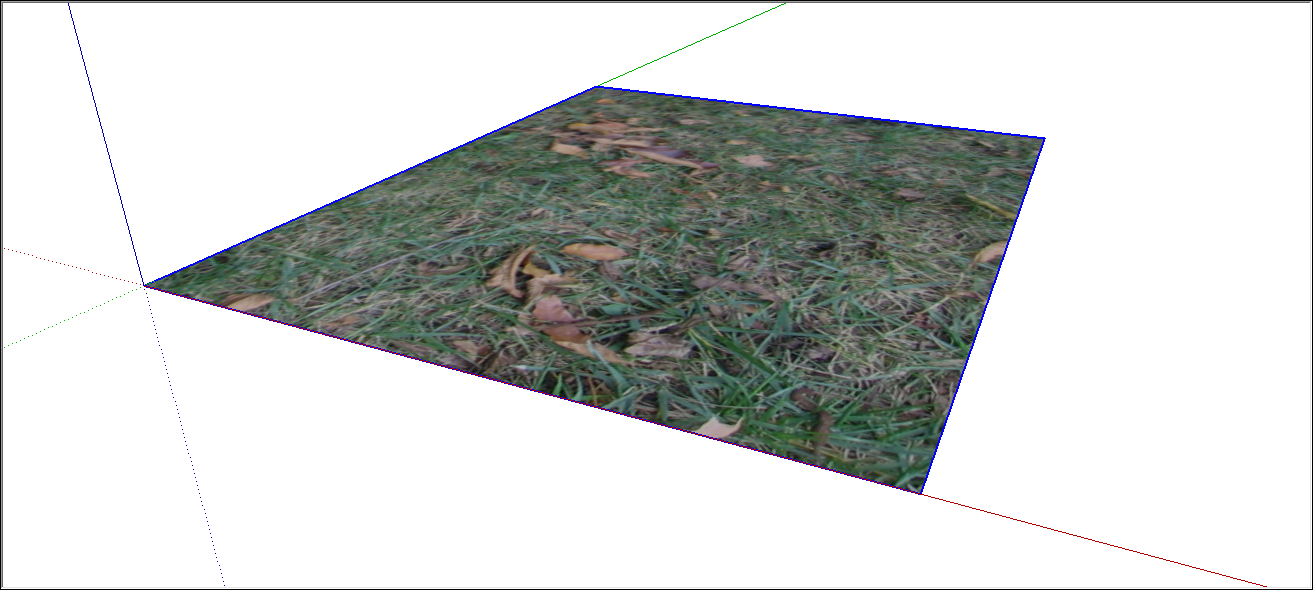
Applying a texture to the side of a building
When you utilize a photo every bit a texture instead of an image, you lot can't place the image anywhere in your model. You need to have a face already fatigued to which you tin can apply the image. However, you do accept a little more control over the texture's positioning on the face up.
Tip: Sometimes it'southward useful to subdivide a face on the side of your building into smaller faces before y'all utilise a photograph texture. This is especially true for very long street-facing walls that are difficult to see in a single photo. Use the Line tool to depict edges that subdivide a face.
The following steps walk you through the procedure of applying a photo texture to flat face and offering a few tips along the manner:
- Select File > Import and select the Use As Texture selection.
- Click in the lower-left corner of the face that y'all desire to photo-texture.
- Click in the upper-right corner of the face up to end applying the image.
- (Optional) If you lot need to stretch the image or arrange its position, context-click the texture and select Texture > Position from the menu that appears. Then context-click the texture again and clear Stock-still Pins, and then that the Position Texture tool is in Free Pin mode. You can and then drag the white pins to each corner of the face to stretch the image or otherwise apply it to the face more than precisely. Click outside the texture when you're done.
Note: For details about the Position Texture tools and Fixed Pins versus Costless Pivot way, see the section on repositioning textures in Adding Colors and Textures with Materials.
Wrapping textures effectually boxes and cylinders
Afterwards you import an image every bit a texture, you can wrap it around an existing box or cylinder, sort of like wrapping paper.
Follow these steps to import an image and wrap it around a box:
- Select File > Import.
- In the Import dialog box, navigate to your image, select it, select Use Equally Texture, and click Import.
- Click on the lower-left corner of the face up on which you desire to get-go wrapping your epitome.
- Then click the upper-right portion of the face. This places your prototype, as shown in the following figure.
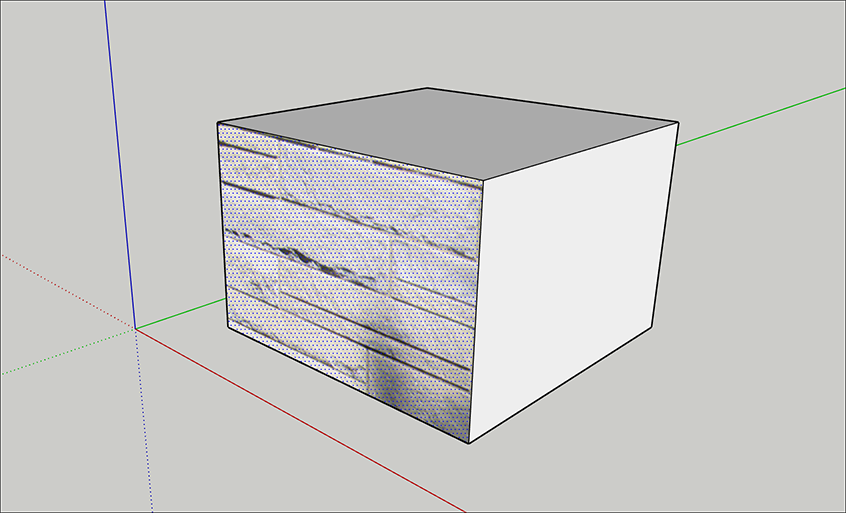
Tip: If you lot demand to stretch or reposition your paradigm after you place it, see the department on repositioning textures in the article Adding Colors and Textures with Materials.
- Select the Paint Bucket tool (
 ).
). - Hold downward the Alt key (Microsoft Windows) or the Command key (macOS) to switch to the Eyedropper cursor.
- Click the texture that y'all applied to the face. The Eyedropper samples your photo.
- Release the modifier key to render to the Paint Bucket tool, and click an adjacent face or faces in your model to wrap the image around information technology, equally shown in the following effigy.

When you wrap a fabric around a cylinder, the steps are the same. However, because a cylinder is made of several faces that are hidden and smoothed, your image may look clipped at first. The following figure shows how the image looks after placing the texture by clicking the bottom border of the cylinder so the top edge.

Even so, later on yous sample the texture with the Eyedropper cursor and click the cylinder with the Paint Bucket cursor, the whole image wraps around the cylinder, as shown in the adjacent effigy.

Projecting textures onto a curved surface
In SketchUp, projected textures are images applied to faces every bit though a slide projector is projecting the image onto your model. Projected textures enable you to apply a texture over a curved surface. This feature is particularly useful for applying a topographic image over a site model, considering topography is rarely flat like the side of a building.
Tip: If your curved surface is a group, open the grouping's context earlier you follow these steps. Alternately, you can explode the group and then turn your curved surface dorsum into a group after you complete the steps. For details almost organizing geometry into groups, see Organizing Your Model.
To project a texture over a curved surface, follow these steps:
- Depict a unmarried, flat confront that matches the dimensions of your curved surface. The post-obit figure shows a top view of a flat surface over a blank terrain.
Tip: Select the flat face and turn on X-Ray way (select View > Style > X-Ray) so you can see the curved surface under the flat surface.
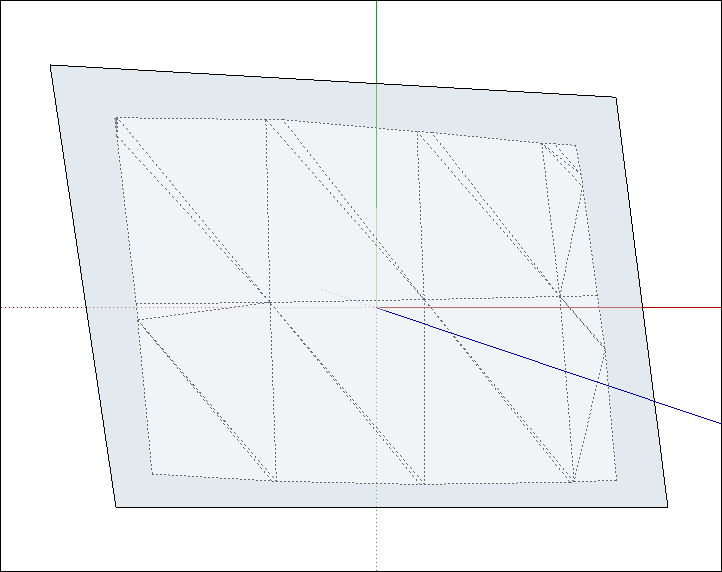
- Import a photograph as a texture, every bit explained in the earlier section Applying a texture to the side of a edifice. Remember that to see this texture, the Face settings in the Styles panel must exist set to Display Shaded Using Textures. (Meet Creating and Editing a Way for details about confront styles.)
- (Optional) If needed, adjust the position of the texture and then it matches your flat face. For case, in the following effigy, you run across the texture in Costless Pivot mode later each pin was dragged to a corner of the flat confront. Run into the section on repositioning textures in Adding Colors and Textures with Materials for details.
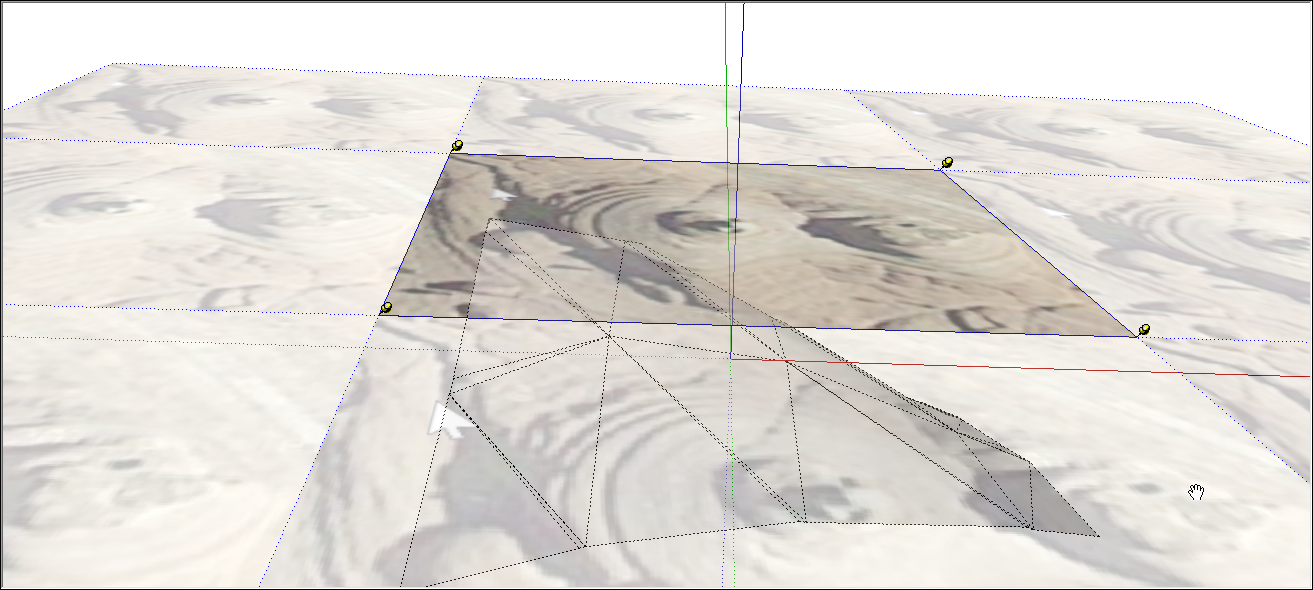
- Context-click the texture that you practical to the flat face, and from the bill of fare that appears, select Texture > Projected. This step transforms the texture into a projected texture, so that the remaining steps work.
- With the Select tool (
 ), select all the faces in your curved surface.
), select all the faces in your curved surface. - Select the Paint Saucepan tool (
 ).
). - Agree downwards the Alt fundamental (Microsoft Windows) or the Control key (macOS), and with the Eyedropper cursor that appears, click the projected texture to sample it. Release the modifier cardinal so the cursor turns back into the Pigment Saucepan.
- With the Pigment Bucket cursor, click the curved surface selection to apply the projected texture to all the faces.
- Delete the flat surface, because you no longer need it. The following effigy shows the projected texture subsequently it'southward applied the curved surface and the apartment surface is deleted.
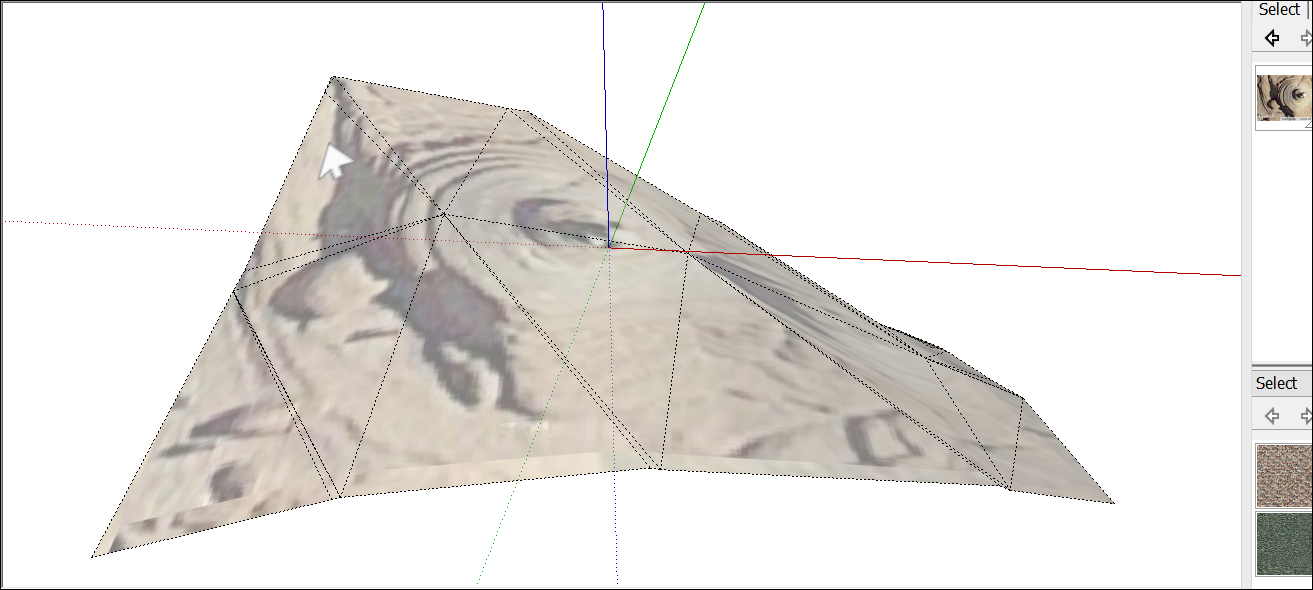
Source: https://help.sketchup.com/en/sketchup/sticking-photo-or-texture-face
0 Response to "How to Paint Uploaded Photo in Sketch Up"
Post a Comment